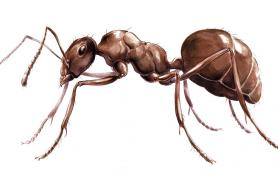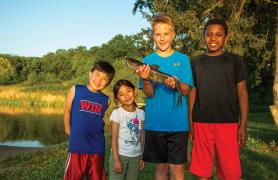Fun Things To Do and Great Places To Discover Nautre
- Notice more hummingbirds at your feeders? They’re fueling up for migration. To make nectar, mix one part white table sugar with four parts water.
- Beat the summer heat. Try night fishing for crappie. All you need is a flashlight, a pole, some bait, and a grown-up to help you find a good fishing hole. Browse places to fish at mdc.mo.gov/atlas.
- In late July, listen for katydids singing, “Katy did, Katy didn’t,” in the trees at night.
- In late August, male white-tailed deer rub the velvet off their antlers. Look for their rubs on small trees.
- Go for a hike, but carry a stick to keep spider webs off your face. This time of year, spiders start spinning webs between trees at eye level.
- Don’t miss the total solar eclipse on August 21! Missouri is a prime spot to see this once-in-a-lifetime event. Looking for more ways to have fun outside? Find out about Discover Nature programs in your area at mdc.mo.gov/events.
What is it? Don’t Know?
- Some people call me possum on the half shell.
- But I’m more like a knight of old.
- I’m armored from my nose to my pointed tail.
- And I clash with my foes on the road.
The nine-banded armadillo has very little hair, so its main strategy for surviving cold weather is to stay in its burrow. In warm weather, it sniffs along the ground for insects and worms, which it digs up and flicks into its mouth with its long, sticky tongue. Armadillos are active at night, and their hearing and eyesight are poor. When threatened, they jump straight up into the air. This is why you see so many dead ones along roadsides.
Xplor More
Tongue Tied
Some woodpeckers can stick out their tongues more than twice the length of their beaks. They use their super-long slurpers to search for food inside hammered-out holes. The tongues are pointy and sharp, perfect for spearing unlucky insects. Many woodpeckers have tongues that are covered with barbs.
These keep squirmy bugs from wiggling off. And the tongues are coated in sticky spit, which helps the head banging birds rake meals back into their yappers.
Critter Corner
American Badger
The stout, low-slung badger is related to weasels, otters, and wolverines. Badgers are known for their snarly tempers. With their long-clawed paws, they can dig faster than their burrowing prey, and they mainly feed on ground squirrels, mice, rabbits, lizards, and snakes. In Missouri, badgers live on open prairies and farmland. You’ll be lucky to see one because they’re active mostly at night. Learn more at mdc.mo.gov/field-guide.
Also In This Issue


This Issue's Staff
Les Fortenberry
Karen Hudson
Angie Daly Morfeld
Noppadol Paothong
Marci Porter
Mark Raithel
Laura Scheuler
Matt Seek
David Stonner
Nichole LeClair Terrill
Stephanie Thurber
Cliff White






















